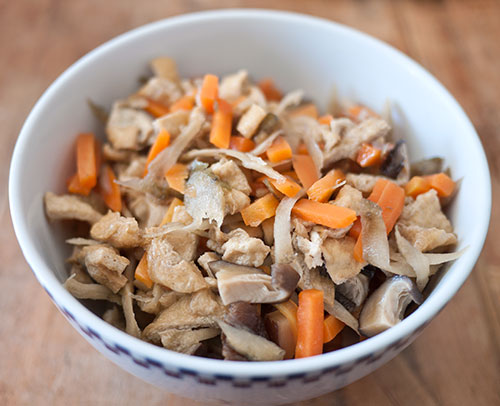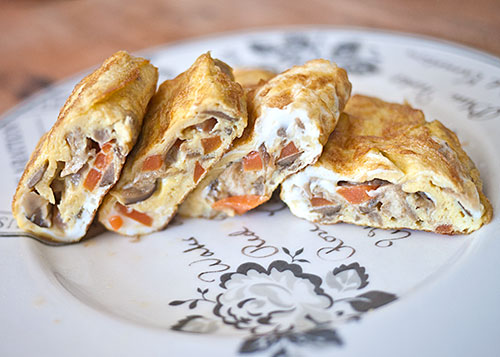Bento staple: All-purpose winter vegetable mix for rice and more

This is a very versatile vegetable-only or vegetable and chicken mix that can be kept in the refrigerator for up to a week, or for a month in the freezer. As long as you use a vegetarian/vegan protein it will be vegan/vegetarian, but if you are an omnivore you can use chicken. Let me give you the recipe first, and then show you a couple of ways to use it.
Recipe: All-purpose vegetable or vegetable-and-chicken mix
This makes about 800ml or 3.5 U.S. cups.
The basic ingredients are very Japanese but I have given some alternatives for the slightly harder to get ingredients. In each case the first listed one is the best choice.
(The instructions may look a bit complicated but they really aren't. What you're doing is just chopping up some root vegetables, mushrooms and protein and simmering it in a stock and sake/mirin/soy sauce/salt mixture. The resulting mixture can then be combined with other foods.)
- 4-5 dried shiitake mushrooms, OR 4 fresh shiitake mushrooms, OR 6-8 button mushrooms
- 1 medium carrot
- one 6-inch piece of burdock root (gobo) OR salsify, OR a medium parsnip
- 1 aburaage (fried bean curd), or 120g / 4 oz boneless skinless chicken (thigh is preferred but breast is ok), or an equivalent amount of firm vegetarian protein of your choice such as seitan, quorn, etc.
- 400ml / 1 3/4 U.S. cups of the shiitake mushroom soaking liquid, with added dashi stock if there's not enough. If you aren't using dried shiitake, use all dashi. You can also use water plus 1 teaspoon of dashi granules. If you don't have any of the above, use your favorite vegetable stock.
- 1 tablespoon sake (omit if you don't have this)
- 1 tablespoon mirin (use 1/2 tablespoon sugar if you don't have this)
- 1 1/2 tablespoon light soy sauce, OR 1 1/2 tablespoon dark soy sauce
- 1/4 teaspoon salt
The mushrooms: If you're using dried shiitake mushrooms, cover them in water and let them soak and reconstitute. This usually takes at least an hour, so you may want to put the mushrooms in water and leave them overnight. Take the mushrooms out of the soaking liquid and squeeze out tightly. Reserve the soaking liquid. Slice the mushrooms thinly (whichever kind you are using). Set aside.
The root vegetables: Peel and cut the carrot and the burdock root or burdock-alternatives into small matchsticks (fine julienne). Put in a bowl and cover with water, and leave to soak for about 5 minutes. If you're using burdock root you will need to change the water once or twice to get rid of some of the bitterness. If the water is very dark, just drain it off, fill with fresh water, and soak for a few minutes more before draining again.
The protein: If you're using fried bean curd, pour boiling water over it to get rid of the surface oil. When cool enough to handle cut into fine julienne. If using the alternative proteins, cut them into small pieces.
Put the 400 ml / 1 3/4 U.S. cups of mushroom soaking liquid + dashi or stock (or all dashi or stock if you're using fresh mushrooms), soy sauce, sake, mirin, and salt into a pan. Add the vegetables and mushrooms and bring it to a boil. Lower the heat and simmer for 10 minutes. Add the protein you are using and simmer for another 4-5 minutes. Take off the heat and let it cool down in the cooking liquid.
Store in a covered container in the refrigerator for up to a week, or in the freezer for up to a month.
Note: On its own this may taste a bit salty, but keep in mind that you'll be using it by combining it with a bland food, so don't worry if you find it a bit strong when you taste it on its own. (And conversely if it tastes a bit low in salt, add a bit of soy sauce and/or salt.)
What to do with the mix
As I showed you in the bento posted yesterday, you can use the mix to make a very tasty and fiber-rich takikomi gohan or mixed rice. There are two methods:
- If you're cooking fresh rice: Rinse the rice as usual (see intructions). When you put the rice in the pot or rice cooker, add 4 tablespoons of the cooking liquid the mix is in, and top up with water to the required amount. Cook the rice as usual. When you reach the heat-off, steaming stage - or if you're using a rice cooker, when the cooking stage is over - put 1 cup of drained mix per 1 cup of raw uncooked rice you put in (so 1/2 cup per 1 cup of cooked rice) on top of the steaming hot rice, put the lid back on and let it rest for 10 minutes or so. Open the lid and mix the rice and the mix together evenly.
- If you're using premade plain rice: Heat up the rice so it's piping hot. Add 1/2 cup of drained mix and 1 tablespoon of the cooking liquid per cup of precooked rice. Cover and let it rest for 5-10 minutes, then mix it all together.
The rice below is actually the mix combined with shari or sushi rice - that is, plain rice flavored with sushi vinegar. It makes a great vegetable sushi on its own, or you can put other things on top to make it into a chirashizushi, or stuff it into prepared fried bean curd pouches for inarizushi. For sushi rice, add 1/2 cup of drained mix per 1 cup of prepared sushi rice, and don't add any of the cooking liquid (since the rice is already flavored with the vinegar mix).

You can also add the mix to egg for tamagoyaki - use the traditional multi-egg method or the 1-egg method. Just add 1 tablespoon of the mix and 1/2 teaspoon of the cooking liquid per egg. (Some people may want to add a pinch of salt, but I prefer it to be less salty.) Mix it up and cook as you would a plain tamagoyaki - don't be too worried about thin layers though, just make a tight little omelette basically. This is a nice alternative to a regular tamagoyaki.

I'll show you one more way to use this mix next time, that uses tofu - a classic shojin ryouri (mostly vegan Zen Buddhist cuisine) dish.
If you enjoyed this article, please consider supporting this site by becoming my patron via Patreon.
